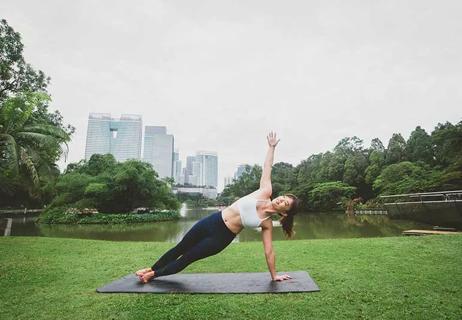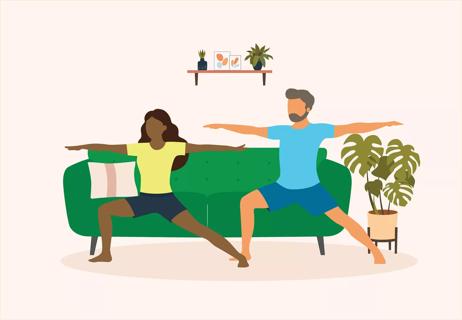The healing benefits of trauma-informed practices

When we hear the word “trauma,” we often think of the worst moments of our lives. The ones that haunt us and make it harder to navigate through life. But sometimes, minor incidents can leave the deepest wounds. So, how can yoga help you heal? Yoga therapist Paula Brown, C-IAYT, E-RYT 500, explains what trauma-informed yoga is and how you can benefit from it.
Advertisement
Cleveland Clinic is a non-profit academic medical center. Advertising on our site helps support our mission. We do not endorse non-Cleveland Clinic products or services. Policy
When you experience trauma, it might be hard to pinpoint what you’re feeling. It’s also hard for your body and brain to comprehend everything. As a result, your muscles tense up and your brain might go into overdrive because you’re constantly trying to protect yourself. Eventually, you might shut down — or lash out.
“It doesn’t have to be a major event in someone’s life. It can be just something gradual — something insidious — that just slowly seeps in and you don’t even realize it. Then, at some point, you realize that you don’t feel good and you’re not sure why. That’s trauma,” says Brown.
Trauma-informed, or trauma-sensitive yoga, is not designed to take you back to the source of your pain. Its purpose is to help you become more aware of what’s going on in your body. Once you tap into that, you can work on releasing built-up emotions, stress and tension.
“When you experience trauma, the pathways that connect in your brain can disconnect. So, when people go to a therapist and they try to talk about what happened, they literally can’t find the words. That’s part of the trauma response. We’ve learned that those pathways have to be reconnected before you can start verbally working through your trauma,” Brown explains.
Advertisement
“With trauma-sensitive yoga sessions, teachers are aware that people in the class may be living with trauma. So, they’ll offer options that will make students feel less vulnerable,” says Brown.
One example of this is instead of asking students to close their eyes, a teacher might encourage them to lower their eyes or look down. “In yoga, the purpose of closing your eyes is to eliminate distractions. But for someone who is living with trauma, it can be scary or unsettling to close the eyes,” Brown explains.
As a yoga therapist, Brown leads group and one-on-one trauma-informed yoga sessions regularly. She says that trauma-informed yoga practices look much different from what you might encounter at a yoga studio.
“In a group yoga therapy situation, I wouldn’t practice with participants sitting in a circle. In a circle, someone is always facing you, which can feel uncomfortable or even threatening. When someone is just starting, they need to become aware of their bodies and physical sensations and focus on themselves without judgment — without adding any negativity on top of what they’re feeling,” notes Brown.
She adds that if she notices someone is starting to get anxious or feel uncomfortable in a group practice, she’ll back away from the pose and work around it. “There’s just going to be constant reassurance, offering of a lot of different options and being more aware of positions that could make people feel vulnerable.” She also won’t walk around the room or touch anyone in these sessions. The reason is that you always want to respect someone’s personal space.
In a one-on-one session, there’s a lot more dialogue to develop a customized plan developed around an individual’s specific needs. It’s most important to create an environment that feels safe.
Breathwork also plays a huge role.
“First of all, we know the breath has a lot to do with how you feel. If you’re anxious, you tend to take short inhaling breaths and you don’t exhale all the way. So, we’re going to focus on the exhale. And if you’re depressed, we’re going to try to bring that energy up and focus on the inhale. Overall, there’s going to be a lot more checking in during a one-on-one session,” Brown explains. “The yoga therapist must establish a relationship of trust and confidentiality.”
According to Brown, the combination of yoga and trauma therapy is fairly new. But the benefits are pretty impressive.
One study showed that trauma-informed yoga significantly reduced the symptoms of post-traumatic stress disorder (PTSD) and the effects of it were comparable to well-researched psychological and medicinal methods. The study involved 64 women who were living with chronic, treatment-resistant PTSD. The women were randomly assigned to either trauma-informed yoga or supportive women’s health education. At the end of the study, 16 of 31 participants (52%) in the yoga group no longer met the criteria for PTSD as compared to six of 29 participants (21%) in the group that received women’s health education.
Advertisement
Trauma can send your brain into overdrive. You might find yourself constantly on guard and unable to relax. Trauma-informed yoga can help you focus on what’s going on in that moment and recognize what’s going on in your body. It also can help you focus on your breath, which as Brown mentioned, can greatly affect your mood.
When your mind is racing, your muscles are tense and you’re always on edge, you don’t feel like yourself — and you don’t feel like you’re safe. Trauma-informed yoga is practiced in a safe space with teachers or therapists who respect you and your boundaries. They can help you learn how to control and manage what your body and mind are going through. As you combine movement and breath, you start building back those mind/body connections. They can also help you understand and tolerate the sensations you’re feeling so you no longer feel like a stranger in your own body.
Brown advises that when you’re looking for this type of yoga practice, make sure the instructor is certified in trauma-informed yoga. But there’s no surefire way to judge beforehand if a certain class is right for you. It mainly comes down to trial and error — try a few sessions and see how you feel. If you’re not sure how to find classes, reach out to yoga studios in your area and ask. You can also search online for trauma-informed yoga professionals near you. A mental health professional might be able to make referrals as well.
Advertisement
Learn more about our editorial process.
Advertisement

Kids’ yoga can help kiddos become more aware of their physical, mental and emotional selves

This mindful practice is designed to give you mental and physical relaxation

Both practices are worth exploring and offer amazing health benefits

You can work more than your abdominals

From using props to practicing on the go, yoga offers an array of benefits

Soap and water will do the trick, but only consider disinfecting if you share a mat

Select a yoga class that focuses on your breath and promotes kindness toward yourself

Find out how they can help at any level

Type 2 diabetes isn’t inevitable with these dietary changes

Applying a hot or cold compress can help with pain